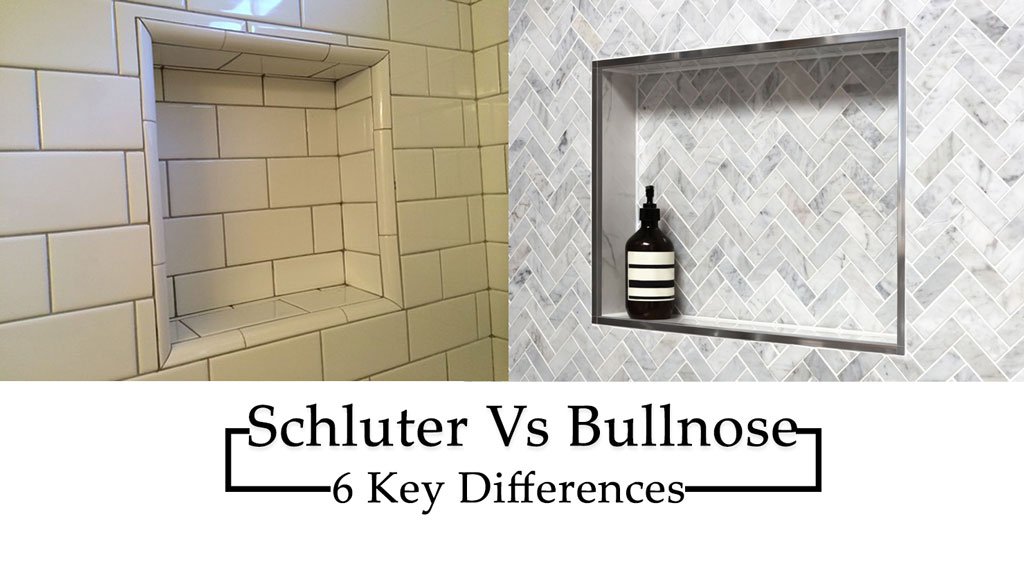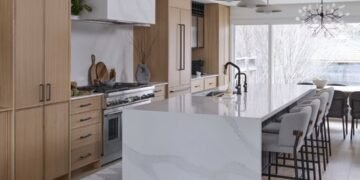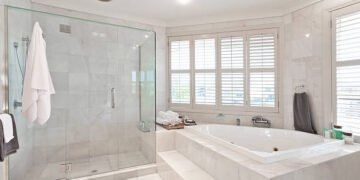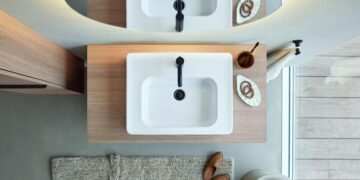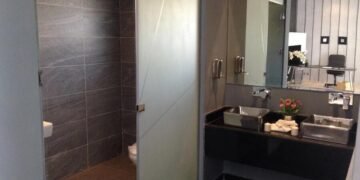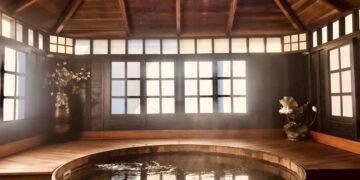When starting the remodeling process, especially for the kitchen and bathroom such as tiling, it is inevitable that the words schluter and bullnose will come up. So, what are they?
Schluter metal strip and bullnose edging are optional to ensure that the edge of the installed tile transitions smoothly to the following material. This is because when the tile is cut, it breaks and does not have a straight and smooth edge.
Both options are great, but we need to choose one that is more suitable for you. Consider the space where the tile is being installed and the look you are trying to achieve. So, we have covered the key differences between schluter vs bullnose in this article to make your choice easy.
What is Bullnose?
A bullnose is a way to smooth the edge of a tile transition to another material or surface. However, the bullnose is not a material but a solid tile edge. It is a rounded edge in the title itself. Generally, bullnose tile trim is used for edging and finishing walls, countertops, and backsplashes in kitchens and bathrooms but can also be incorporated into other home or business areas.
Moreover, the bullnose border is not only for aesthetics but also for practical purposes. Rounded border help to prevent chipping and provide structural support to the countertops. Additionally, it creates a smooth transition between the countertops and any surrounding surface, such as the backsplash or wall.
It is important to note that bullnose edging is not available for all tile types but can accommodate a variety of tile styles. Bullnose tile trim is available in various shapes and materials, including ceramic, porcelain, and natural stone.
Bullnose has a rounded border, adding a soft touch to the overall design. It is very versatile and can complement both contemporary and traditional design. This bullnose border can provide a smooth finish to any tile surface if it is cut and installed correctly.
Some other materials, like marble and granite, naturally have a rounded bullnose border during the shaping process due to their unique properties. Different materials like ceramic tile may require special tools to achieve this edge style.
When the bullnose border is installed, it is essential to measure and cut the tile properly, so it fits well. Once the cut process is over, the tile can be applied using a trowel and thin-set mortar. Carefully press the tile firmly and eventually press it into the desired place.
While providing durability and functionality, this bullnose border offers a classic look that can complement any design aesthetic. Consider style and function when deciding on an border profile for your countertops.
This border is a good choice as it makes the tile more durable and less likely to break due to daily wear and tear. A bullnose edge can also refer to the rounded corner of a countertop or tile. This edge adds a softer look to the overall design and can help to prevent injury from sharp sink angles.
Bullnose’s smooth, rounded corner adds softness and contrasts with the linear tile pattern. It can be counted as a decorative accent to a backsplash and wall. Switching bullnose edge tile is an easy way to improve the overall look of any tiled surface.
For most carpenters installing trim, this creates a third center point to intersect two trim boards. Simply joining two board cuts with a 45-degree miter leaves a gap, which prevents a nice and tight fit.
Instead, carpenters (or experienced DIYs) use a series of four 22.5-degree cuts to achieve the look of rounded bullnose corners. Finally, bullnose corners are derived from earth-based adobe structures or composed of natural and organic materials.
This bullnose should also be grouped with other matching colors to blend seamlessly with the rest of the tiles. This finishing touch adds visual appeal and functionality to any tiling project.
Most Common Types of Bullnose Tile Shapes
Rectangular bullnose trim is most common, especially when outlining tile backsplashes, countertops, and other transitions.
Corner bullnose Pisces has two rounded border for corner mounting on a wall or backsplash.
Square bullnose trim is popular with clients who want to maintain a consistent checkerboard look in tile designs.
What is Schluter?
Schluter is generally a tile border trim material usually made from aluminum or stainless steel. They can be used as edge protections for a divider between different types of tiles or exposed tile borders. The role of those Schluter metal strips is essential to provide support and reinforcements for the tile borders, helping to prevent chipping and cracking.
A metal “L” corner, installed before laying tiles, will not only serve as edge protection,” explains the creator of schluter metal strips. But, also hide the unglazed borders and provide a straight and clean transition to the surrounding surface.
They create a smooth transition between tiles and surfaces, such as countertops or shower walls. Schluter metal strips are manufactured from durable corrosion-resistance material, ensuring long-lasting stability in wet environments.
With proper precautions and maintenance, these Schluter metal strips last very long. Schluter tile edges create a smooth transition between the tile and other surfaces. They also help to create decorative accents on tiled floors and walls.
They also provide extra protection against chipping and cracking at the borders of tiles. The installation process is easy with their secure anchoring and self-adhesive backing method.
Their square borders gives a perfect yet simple and sophisticated look when transitioning from one tile to another, elegant or around the corner. Not to mention, especially for bathrooms, homeowners can easily coordinate Schluter’s colors with other shower hardware and other fixes such as light and vanity handles.
Generally, they come in a variety of finishes and also heights so that you can match these metal strips to any remodeling. Use appropriate caulking and adhesives to ensure secure bindings.
Furthermore, Schluter metal strips come with versatile options for any tiling options. They are straightforward to install and can be cut to fit almost every home space. These strips can help you to enhance the aesthetic appearance of tired surfaces by creating seamless and clean lines.
Ensuring proper spacing and alignment when installing Schluter strips is essential for optimal performance and visual appeal. Precise placement of the tiles may require using specific tools like a tile snip or some balancing tools.
4 Schluter Profiles Designs
Floor profiles protect tile borders from chipping or cracking during the transition to other floor coverings.
Cove-shaped profiles provide rounded transitions at wall corners and where walls meet the floor. This reduces dirt build-up and makes cleaning easier.
Wall and countertop profiles are designed to finish tile borders on exterior wall corners, bases, wainscoting, and more.
Stair-nosing profiles finish and protect tile borders while providing a safe, slip-resistant surface.
Key Differences Between Schluter vs Bullnose.
Although they may have similar roles and high-quality options, Schluter and Bullnose are two different methods of finishing an exposed tile border.
1. Design
The overall design is the first significant difference between the Schluter and the Bullnose. Schluter has an L-shaped profile with two perpendicular edges. On the other hand, bullnose tile is traditionally rounded at one end to create a smooth, curved finish.
In addition, Schluter can serve both aesthetic and functional purposes, while Bullnose tile is generally used for decorative purposes.
For example, Schluter can transition between carpet and tiles or protect exposed borders. They are made of different materials, which is a significant difference. Generally bullnose tile is made of those materials like other surrounding tiles around the market, while Schluter is usually made from metal or plastic.
2. Durability
The Schluter Shower System is known for its excellent waterproofing ability in modern bathrooms. A Schluter product can last more than fifty years if cared for properly. The attachment may be simple but highly effective in the long run.
Bullnose tiles are still used at home for hiding rough borders and finding the tile design. Still, the marvels could be more durable and versatile than Schluter. On average, Bullnose tiles last at least eight to ten years with proper care.
3. Installation
Regarding installation, Schluter requires more precise measurements and a professional installer. In contrast, bullnose can often be DIY-installed with minimal inconvenience.
It is also essential to factor this in when calculating the overall coat, as Schluter tends to be more expensive. If you are determined to finish the tile design yourself, the bullnose method may be a better choice, especially if you have little expertise in this area.
4. Protection
Schluter tiles are the favorite DIY products for most homeowners. Schluter kits provide much better waterproof protection when installed in wet places.
Bullnose tiles are installed at the end of the DIY projects. In fact these are classic design tiles in the market. Still, the blocks protect corners and function well as decorative trim.
5. Scope(where is it used)
Both Schluter and bullnose tiles are primarily installed in wet rooms. In fact they both hide exposed tiles and work as decorative protection. Applications include bathroom, and kitchen countertops, backsplashes, and swimming pool tile borders
Try to install these tiles at tiled shower niches, corners, movement joints, outside borders of a backsplash, and other wet areas.
6. Costing
In terms of cost, Schluter tends to be more expensive due to its durable construction and multi-functionality.
Bullnose is usually more affordable than Schluter but may not be as durable or versatile as Schluter.
Conclusion – Which is Better Choice?
So, which should you choose? Schluter vs Bullnose. Both border options are durable, safe choices, and aesthetically pleasing. This is no right decision, but it rather depends on the preference. In many modern bathroom and kitchen remodels, Schluter is a popular choice. Still, a handful of people are looking for an elegant, more rustic feel, and they generally prefer to go with bullnose.
Regarding cost, there are many variables, with the most significant cost factor being the type of tile selected. Remember, this is while you are remodeling your kitchen and bathroom. Do your research, assess where the bullnose tile or Schluter will be installed, and choose which best suits your needs and style!
Recommended Posts:

